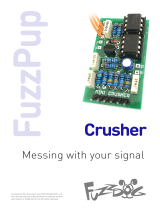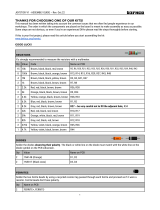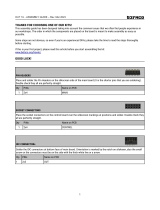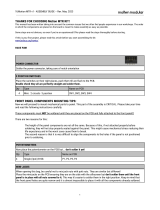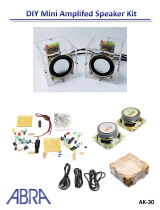Page is loading ...

1
Lazy Sprocket Kit Instructions
Warranty:
BYOC, Inc. guarantees that your kit will be complete and that all parts and components
will arrive as described, functioning and free of defect. Soldering, clipping, cutting,
stripping, or using any of the components in any way voids this guarantee. BYOC, INC
guarantees that the instructions for your kit will be free of any majors errors that would
cause you to permanently damage any components in your kit, but does not guarantee
that the instructions will be free of typos or minor errors. BYOC, INC does not
warranty the completed pedal as a whole functioning unit, nor do we warranty any of the
individual parts once they have been used. If you have a component that is used, but feel
it was defective prior to you using it, we reserve the right to determine whether or not the
component was faulty upon arrival. Please direct all warranty issues to:
[email protected] This would include any missing parts issues.
Return:
BYOC, Inc. accepts returns and exchanges on all products for any reason, as long as they
are unused. We do not accept partial kit returns. Returns and exchanges are for the full
purchase price less the cost of shipping and/or any promotional pricing. Return shipping
is the customer’s responsibility. This responsibility not only includes the cost of
shipping, but accountability of deliver as well. Please contact
[email protected] to receive a return authorization before mailing.

2
Tech Support:
BYOC, Inc. makes no promises or guarantees that you will successfully complete your
kit in a satisfactory manor. Nor does BYOC, Inc. promise or guarantee that you will
receive any technical support. Purchasing a product from BYOC, Inc. does not entitle
you to any amount of technical support. BYOC, Inc. does not promise or guarantee that
any technical support you may receive will be able to resolve any or all issues you may
be experiencing.
That being said, we will do our best to help you as much as we can. Our philosophy at
BYOC is that we will help you only as much as you are willing to help yourself. We
have a wonderful and friendly DIY discussion forum with an entire section devoted to the
technical support and modifications of BYOC kits.
www.byocelectronics.com/board
When posting a tech support thread on the BYOC forum, please post it in the correct
lounge, and please title your thread appropriately. If everyone titles their threads
“HELP!” then it makes it impossible for the people who are helping you to keep track of
your progress. A very brief description of your specific problem will do. It will also
make it easier to see if someone else is having or has had the same problem as you. The
question you are about to ask may already be answered. Here is a list of things that you
should include in the body of your tech support thread:
1. A detailed explanation of what the problem is. (more than, “It doesn’t work, help”)
2. Pic of the topside of your PCB.
3. Pic of the underside of your PCB.
4. Pic that clearly shows your footswitch/jack wiring and the wires going to the PCB
5. A pic that clearly shows your wiring going from the PCB to the pots and any other
switches (only if your kit has non-PC mounted pots and switches)
6. Is bypass working?
7. Does the LED come on?
8. If you answered yes to 6 and 7, what does the pedal do when it is in the "on" position?
9. Battery or adapter (if battery, is it good? If adapter, what type?)
Also, please only post photos that are in focus.
Copyrights:
All material in this document is copyrighted 2018 by BYOC, Inc.

3
Parts Checklist…………………………..page 5
Populating the Circuit Board…………..page 6 - 13
Assembly………………………………....page 14 - 16
Wiring………………………………........page 17 - 20
Finish up………………………………....page 21
Operating Overview…………………….page 22
Schematic...................................................page 23

4
This is what your build should look like when it’s done. Your kit may include
different color components; this is nothing to worry about as long as the values are
correct.

5
Parts Checklist for The Lazy Sprocket Kit
Resistors:
1 - 390ohm (orange/white/black/black/brown)
1 - 470ohm (yellow/purple/black/black/brown)
3 - 1k (brown/black/black/brown/brown)
1 - 3.3k (orange/orang/black/brown/brown)
3 - 4.7k (yellow/purple/black/brown/brown)
3 - 10k (brown/black/black/red/brown)
3 - 22k (red/red/black/red/brown)
1 - 47k (yellow/purple/black/red/brown)
3 - 100k (brown/black/black/orange/brown)
2 - 220k (red/red/black/orange/brown)
1 - 390k (orange/white/black/orange/brown
1 - 470k (yellow/purple/black/orange/brown)
4 - 1M (brown/black/black/yellow/brown)
Capacitors:
1 - .001uf film (may say 102 on the body)
2 - .022uf film (may say 223 on the body)
1 - .033uf film (may say 333 on the body)
2 - .047uf film (may say 473 on the body)
7 - 1uf aluminum electrolytic
3 - 10uf aluminum electrolytic
1 - 47uf aluminum electrolytic
1 - 100uf aluminum electrolytic
IC:
1 - 741 or TL071 or similar single op amp
Transistors:
5 - 2n3904 or similar NPN silicon transistor
1 - 2n5457 or similar JFET
Diodes:
4 - 1N914 or 1N4148(smaller diodes)
1 - 5.6v zener (larger diode)
Potentiometers:
1 - 10k trimpot
1 - A100k Audio pot “sensitivity”
1 - B25k Linear pot “attack”
Hardware:
1 - enclosure w/ 4 screws
1 - lazy sprocket circuit board
1 - 3pdt footswitch
2 - knobs
1 - AC adaptor jack
2 - Enclosed jacks
2 - Lock Washers
1 - battery snap
1 - red LED
4 - Rubber Bumpers
hook-up wire

6
Populating the Circuit Board
Step 1: Add all the resistors. Resistors are not polarized, so they can face in
either direction.

7
Step 2: Add the diodes. The smaller 1N914 are highlighted in red. The
larger zener is highlighted in yellow. Make sure the black stripe on each
diode matches with the stripe on the layout.

8
Step 3: Add the IC socket. Match up the u-shaped notch in the socket with
the notch on the layout. If the op amp that is supplied with your kit does not
have a notch in it, there will be a small dot in one corner. This denotes pin
#1. Pin #1 of the op amp should go in the square solder pad.

9
Step 4: Add the trimpot. When you are finished with your build, adjusting
this trimpot will be very important. When you set the trimpot, you want to
have the attack knob turned full turn clockwise so that it should produce the
slowest swell. Then adjust the trimpot to the sweet spot where you get a
smooth, slow swell, but not too much volume loss.

10
Step 5: Add the transistors. The 2N3904s are highlighted in red. The
2N5457 is highlighted in yellow. Make sure that the transistors' curved
sides and flat sides match the layout.
Using a SK30 JFET: If you wanted to use an SK30 JFET, the PCB has
eyelets to accommodate this. The SK30 has a different pinout from 2N5457.
Insert the SK30 into the PCB in the transistor space highlighted in yellow
following the same orientation, but with the lower leg of the transistor going
into the lower ‘D’ eyelet.

11
Step 6: Add the film caps. These are not polarized and can go in either
direction.

12
Step 7: Add the electrolytic capacitors. These are polarized, meaning they
have a positive and negative end. The positive end of the cap will have a
longer lead and should go in the square solder pad.

13
Step 8: Add the battery snap. Thread the wires of the battery snap through
the holes in the PCB before soldering as shown below.

14
Main PCB Assembly
Step 1: Mount the AC adapter jack to the enclosure. Your kit may come
with either an external thread or internal thread. Don’t get confused by this.
They still function exactly the same. You just thread the external nut on the
outside and the internal nut on the inside. The picture below is of an internal
nut jack.

15
Step 2: Flip the PCB over so that the bottom or solder side is up. Insert the
four potentiometers, toggle switch and the LEDs into the bottom side of the
PCB. DO NOT SOLDER ANYTHING YET!!!
The LED will have one lead that is longer than the other. THIS WILL GO
INTO THE SQUARE SOLDER HOLE.

16
Step 3: Hold the PCB in one hand so that the component side of the PCB is
in the palm of your hand and the bottom side with the pots, toggle switch
and LED is facing up. Now use your other hand to guide the predrilled
enclosure onto the PCB assembly so that the pots, toggle switch and LED all
go into their respective holes. Once the PCB assembly is in place, secure it
by screwing on the washers and nuts for the pots. Only tighten them with
your fingers. You do not want them very tight yet. Make sure you’ve
removed the nuts and washers from the pots and that you’ve also snapped
the tabs off the pots as well before installing.
Step 4: Turn the entire pedal over so that the component side of the PCB is
facing up. Lift the PCB up off the pots about 2mm just to make sure that the
back of the PCB does not short out against the pots. Make sure the PCB is
level and symmetrically seated inside the enclosure.
Step 5: Solder the pots, toggle switch and LED. You will be soldering on
the component side (top) of the PCB. After you have soldered them in
place, be sure to tighten up their nuts. TIP: only solder one lug of each
component at first. This will secure everything in place and still allow you
to wiggle things around if you need to adjust the fit of anything. Once you
have everything perfect, go ahead and solder everything else.

17
WIRING
Step 6: Connect the TIP (negative) terminal of the DC adapter jack to the
eyelet on the PCB labeled “-“. Connect the SLEEVE of the DC adapter jack
to the eyelet on the PCB labeled “+” farthest to the right. Connect the battery
disconnect terminal of the DC adapter jack to the second eyelet on the PCB
labeled “+” located in the middle of the other two eyelets .

18
You will want to place the jacks into the enclosure so the sleeve terminal is
facing the right like the picture above. Be sure to remember the lock washers
so the jacks don’t spin on their own.
Step 7: Install the footswitch. Orient the footswitch so that the flat sides of
the solder lugs are like the diagram below.
NOTE: There are no actual number markings on the footswitch. There are
two correct ways you can orient the footswitch. They are both 180 degrees
of each other. Either way is fine. It does not matter as long as the flat sides
of the solder lugs are running horizontal, not vertical.

19
FOOT SWITCH SOLDER LUG DESIGNATIONS
Step 8: Insert the foot switch wires into their respective eyelets on the PCB.
You can insert them into the top side and solder on the top side as well. The
solder pads should be large enough (if you are using a soldering iron that
isn’t too big) to allow you to do this without burning the PVC coating on the
wires if you are careful. If you do singe the plastic on the wires, it’s OK.
It’s not going to hurt anything. It’s purely aesthetic.
Step 9: Connect the wires at the top end of the PCB to the IN and OUT
jacks. The “out” eyelet will go to the tip of the OUT jack and the “in” eyelet
will go to the tip of the IN jack. Connect the ground eyelet on the left to the
sleeve of the IN jack and the ground eyelet on the right to the sleeve of the
OUT jack. Connect the “ring” eyelet to the ring of the IN jack. See diagram
below.

20
Finished Wiring
/



